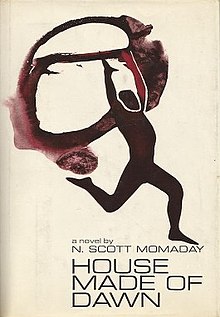House Made of Dawn

First edition cover
|
|
| Author | N. Scott Momaday |
|---|---|
| Cover artist | David McIntosh |
| Country | United States |
| Language | English |
| Published |
|
| Media type | Print (hardback & paperback) |
| Pages | 212 |
House Made of Dawn is a 1968 novel by N. Scott Momaday, widely credited as leading the way for the breakthrough of Native American literature into the mainstream. It was awarded the Pulitzer Prize for Fiction in 1969, and has also been noted for its significance in Native American Anthropology.
With 198 pages, House Made of Dawn was conceived first as a series of poems, then replanned as stories, and finally shaped into a novel. It is based largely on Momaday's firsthand knowledge of life at Jemez Pueblo. Like the novel's protagonist, Abel, Momaday lived inside and outside of mainstream society, growing up on reservations and later attending school and teaching at major universities. In the novel Momaday combines his personal experiences with his imagination – something his father, Al Momaday, and his mother taught him to do, according to his memoir The Names.
Details in the novel correspond to real-life occurrences. Momaday refers in his memoir The Names to an incident that took place at Jemez on which he based the murder in House Made of Dawn. A native resident killed a New Mexico state trooper, and the incident created great controversy. Native American beliefs and customs, actual geographical locations, and realistic events also inspired elements in House Made of Dawn. According to one of Momaday's letters:
Abel is a composite of the boys I knew at Jemez. I wanted to say something about them. An appalling number of them are dead; they died young, and they died violent deaths. One of them was drunk and run over. Another was drunk and froze to death. (He was the best runner I ever knew). One man was murdered, butchered by a kinsman under a telegraph pole just east of San Isidro. And yet another committed suicide. A good many who have survived this long are living under the Relocation Program in Los Angeles, Chicago, Detroit, etc. They're a sad lot of people.
According to one historian, the novel is highly accurate in its portrayal of a peyote service, though in southern California such services normally take place in the desert, not the city.
...
Wikipedia
